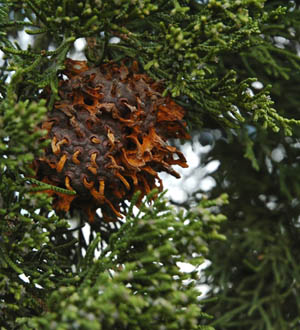Cedar–Apple Rust Galls “Ripe” in Central Illinois | |
|---|---|
| April 30, 2008 | |
|
Cedar–apple rust is a fungal disease that requires two tree species to survive. It lives through winter on eastern red cedar. The warm-season host may be apple or crabapple or a few other rosaceous species. Spores move from one host to another via wind, and it is the basidiospores that infect apple or crabapple foliage. With cedar–apple rust of greatest concern in apple orchards, it is not nearly as problematic in crabapple plantings. This is because resistance is available in most of the new crabapple cultivars, and fungicides used to control scab also control cedar–apple rust on this host. If you have had problems with this rust in the past, now is the time to apply sprays to protect your susceptible crabapple cultivars. As you can see in the image of a cedar–apple rust gall on red cedar in central Illinois on April 25, the galls are swelling and will gelatinize in warm, spring rains.  Given warm, humid conditions, these spores will germinate and release other spores (basidiospores) that can be easily blown to susceptible crabapples. Spray options are listed in the Illinois commercial and homeowner pest management handbooks. For complete protection, the sprays must continue according to label recommendations until 1 to 2 weeks past petal fall. Look at the chemical options at the end of each chapter to determine which products have systemic mobility. The systemic products have some kickback activity if you are bit late in getting the sprays out; and they are less likely to wash off in rainy periods. For more information, refer to Report on Plant Disease, no. 802, “Rust Diseases of Apple, Crabapple, and Hawthorn,” available on the Web at http://www.ag.uiuc.edu/%7Evista/horticul.htm. | |
| Author: | Nancy Pataky |
